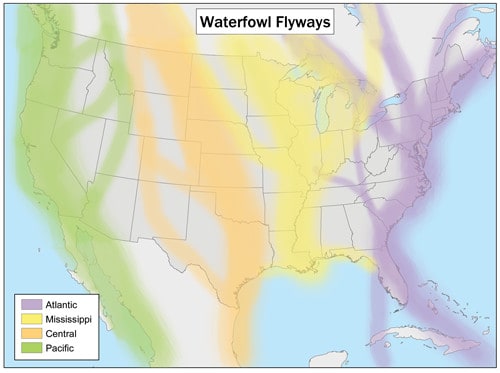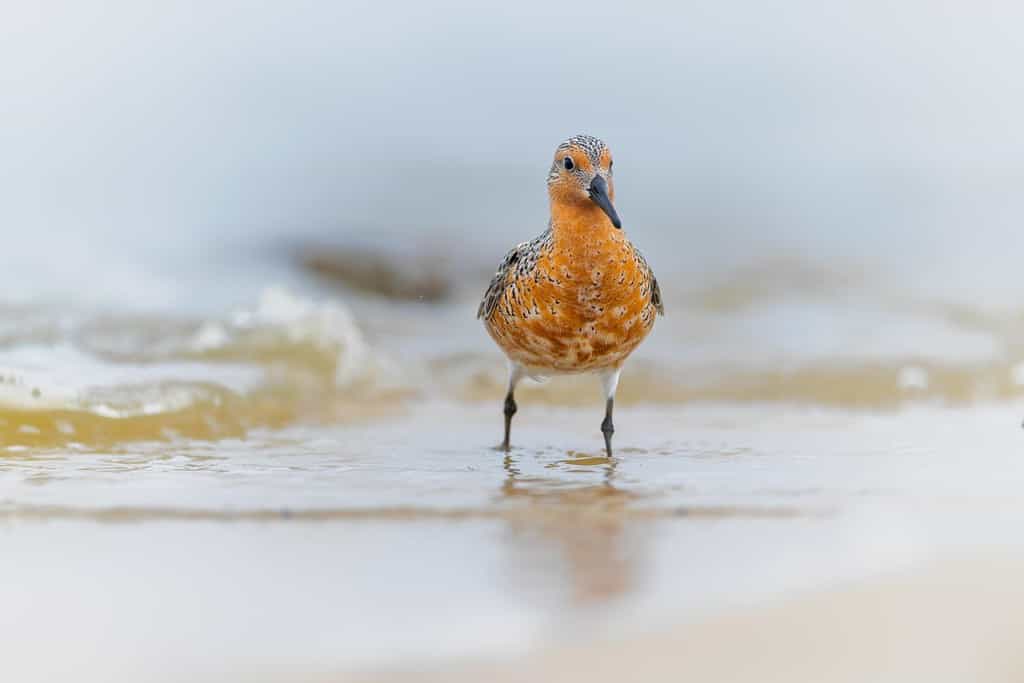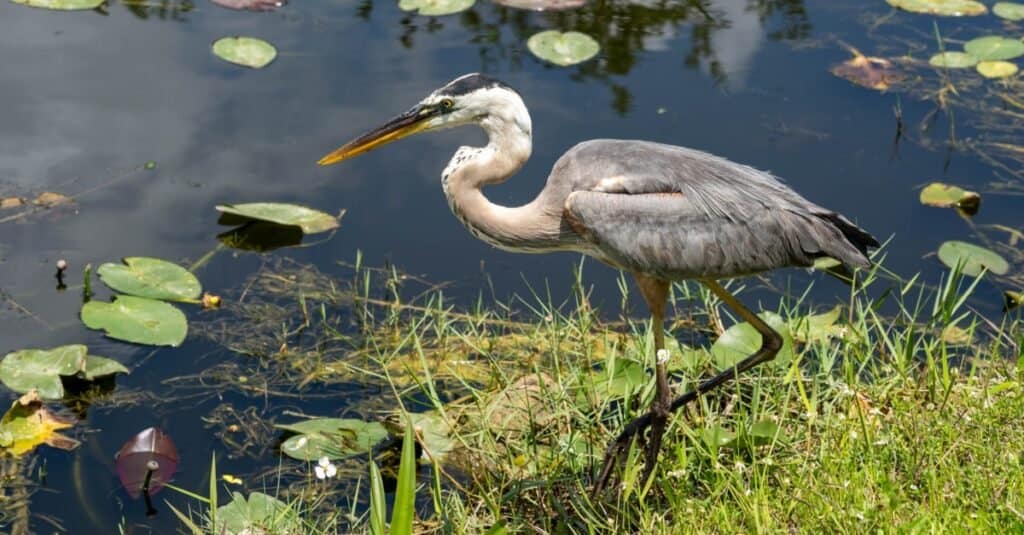There are 4 migratory flyways for birds running north to south across North America. One of these flyways runs up the length of the East Coast. What is the Atlantic Flyway? Why it’s important, and the birds that use it are discussed in detail.
What Is the Atlantic Flyway?

The Atlantic Flyway is the East Coast’s large migratory route for birds.
©This image or recording is the work of a U.S. Fish and Wildlife Service employee, taken or made as part of that person’s official duties. – Original / License
The Atlantic Flyway is one of four important migratory routes in North America used by many bird species. Around 500 types of birds use all or part of this flyway, and without this oceanic path, these birds would not be able to make it to their northern breeding grounds or their southern wintering spots.
The Atlantic Flyway is affected the most by human civilization out of the four major flyways in North America. More people live in the Atlantic Flyway by far. As a result, hunting restrictions and habitat preservation are vital to maintaining the birds’ health using the flyway.
Despite conservation efforts, at least half of the coastal salt marshes needed by Atlantic Flyway users will be destroyed by 2100. Almost 80 percent of the salt marshes needed to stay healthy while migrating will be gone for some species.
Where Is the Atlantic Flyway?
The Atlantic Flyway extends down the East Coast of the Americas. It begins in Greenland, follows the Canadian Atlantic Coast, continues along the eastern United States, moves through the Caribbean, down into the South American tropics, and finally, down into Tierra del Fuego.
The Atlantic Flyway extends east from the Appalachian Mountains to the Atlantic Coast in the United States. The flyway exists because it is a path of least resistance with few mountainous obstacles. There are also lots of marshes and wetlands providing needed resting spots and resources to the birds traveling the coast.
The states that make up the Atlantic Highway in the USA are:
- Connecticut
- Delaware
- Florida
- Georgia
- Maine
- Maryland
- Massachusetts
- New Hampshire
- New Jersey
- New York
- North Carolina
- Pennsylvania
- Rhode Island
- South Carolina
- Vermont
- Virginia
- West Virginia
Why Is the Atlantic Flyway Important?
Without the Atlantic Flyway, a lot of migratory animals on the East Coast wouldn’t be able to travel as far as they do. The Atlantic Flyway is important to game hunters as well as conservationists.
Birds like Atlantic brants are harvested every year as they migrate along the East Coast. In addition to important meat birds, over 40 percent of migrating bird species along the Atlantic Flyway need some kind of conservation to regain their historical numbers.
The types of ecosystems within this flyway are more diverse than the other flyways in the United States. The marshes, wetlands, and swamps found along the eastern seaboard are especially important. These areas are vital to the survival of traveling shorebirds and waterfowl.
Not only do birds use the Atlantic Flyway, but other migrating animals also take advantage of it. Dragonflies, bats, and butterflies are examples of other creatures that traverse this migratory highway.
What Birds Use the Atlantic Flyway?

Red knots undertake a 9 thousand-mile migration using the Atlantic Flyway.
©Buvana Bala/Shutterstock.com
Many important birds use the Atlantic Flyway, including red knots. Red knots undertake over 9,000-mile migrations every year, and they rely on this particular flyway in North America for the northernmost part of their journey. Arctic terns travel even farther from Antarctica to the Arctic Ocean.
Some of the bird species that make use of the Atlantic Flyway include:
- American Black Ducks (Anas rubripes)
- American Golden Plovers (Pluvialis dominica)
- American Oystercatchers (Haematopus palliatus)
- American Wigeons (Mareca americana)
- Arctic Terns (Sterna paradisaea)
- Atlantic Brants (Branta bernicla hrota)
- Blackpoll Warblers (Dendroica striata)
- Black Scoters (Melanitta americana)
- Bobolinks (Dolichonyx oryzivorus)
- Broad Wing Hawks (Buteo platypterus)
- Buffleheads (Bucephala albeola)
- Canada Geese (Branta canadensis)
- Canvasbacks (Aythya valisineria)
- Caspian Terns (Hydroprogne caspia)
- Common Eiders (Somateria mollissima)
- Common Mergansers (Mergus merganser)
- Gadwalls (Mareca strepera)
- Great Blue Herons (Ardea herodias)
- Greater Snow Geese (Anser caerulescens)
- Green Winged Teals (Anas carolinensis)
- Golden-Winged Warblers (Vermivora chrysoptera)
- Hooded Mergansers (Lophodytes cucullatus)
- Long-Tailed Ducks (Clangula hyemalis)
- Piping Plovers (Charadrius melodus)
- Redheads (Aythya americana)
- Red Knots (Calidris canatus)
- Red Necked Phalaropes (Phalaropus lobatus)
- Ring Necked Ducks (Aythya collaris)
- Ruddy Ducks (Oxyura jamaicensis)
- Semipalmated Sandpipers (Calidris pusilla)
- Stilt Sandpipers (Calidris himantopus)
- Surf Scoters (Melanitta perspicillata)
- Tundra Swans (Cygnus columbianus)
- Whimbrels (Numenius phaeopus)
- White Winged Scoters (Melanitta deglandi)
- Wood Ducks (Aix sponsa)
The Florida Everglades Is Important to the Atlantic Flyway

Great Blue Herons are one of 400 species that rely on the Everglades as part of the Atlantic Flyway.
©ttomasek15/Shutterstock.com
One of the most important areas along the Atlantic Flyway in the United States is the Everglades in Florida. It is the biggest and most important breeding area for wading bird species in the United States, and over 400 different species utilize the Everglades as a stopover for foraging or as their wintering destination. This means that 80 percent of the species using the Atlantic migratory route also depend on the Everglades.
The Everglades are a unique wetland environment that covers south Florida. It contains pine forests surrounded by marshes with mangroves along the coast. However, rising sea levels are changing the salinity of the water, which is changing the makeup of the entire region.
The photo featured at the top of this post is © Delmas Lehman/Shutterstock.com
Thank you for reading! Have some feedback for us? Contact the AZ Animals editorial team.







